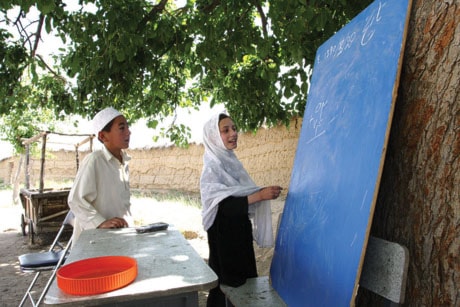Advocate editor Cameron Kennedy arrived in Afghanistan on Friday, accompanying a group of A Better World members who are working on a project to build classrooms for children long denied education in the wartorn country.
Kennedy, who will file regular reports from Afghanistan for the Advocate during his 10-day stay, also toured the country with A Better World co-founder Eric Rajah in 2007.
The narrow dirt road that winds through the labyrinth of high, mud brick walls ends at six shabby tents pitched in a field fringed by small plots of wheat, grapes and tomatoes.
The day is young, but the heat is already stifling inside the tents belonging to Qualai-e-Haji Primary School in the village of Qara Bagh, a one-hour drive north of Afghanistan’s capital, Kabul.
Each tents has about 20 to 25 boys and girls, seated in pairs at cheap wooden desks. They take turns approaching the front of their classes to recite passages from their books on Afghan culture or the English language, among other topics.
There are so many students attending Qualai-e-Haji this year that another 20 to 25 students are sitting on mats in the shade of a large mulberry tree.
The young boy running the lesson scribbles math problems on a large, blue chalkboard propped against the tree for his classmates to solve.
Shajahan Rahimi, the math teacher, said he is grateful to have the tents, but a stone school would be better.
“The tents are good, but during the summer, it is so hot inside,” said Rahimi, adding that the heat makes it difficult for the pupils to concentrate on their studies.
Eric Rajah would like nothing better than to fulfil Rahimi’s wish and build five or six classrooms for the school.
The co-founder of A Better World, Rajah is in Afghanistan this week to identify schools in need of classrooms for the international development organization’s 100 Classrooms for Afghanistan project.
Rajah had fond memories of his previous trip to Qara Bagh in May 2010. The area’s natural beauty reminded him of Alberta’s foothills.
He was also impressed by the villagers’ willingness to take ownership of the school, donating land to it and digging wells to provide clean drinking water.
A Better World looks for those types of contributions before it decides to invest in a project.
“Education is about community,” said Rajah. “If the community doesn’t see education as a priority, there are enough other people around the world who need us to partner with them.”
The act of putting down roots is particularly significant for Qara Bagh’s residents. Many of them recently returned to Afghanistan from living as refugees in Pakistan or Iran.
The Afghanistan government provided the returnees with land. The returnees, mostly farmers and day labourers in Kabul, were responsible for building themselves a home with materials provided by the Adventist Development and Relief Agency’s Afghanistan office.
What the returnees did not have were proper classrooms for the growing number of students.
In May 2010, about 140 students studied in the shade of the trees behind the local mosque. Today, almost 400 boys and girls attend Frades 1 through 6 at Qualai-e-Haji in two shifts: 6:30 to 9 a.m. and 9:15 a.m. to noon. Older students must attend classes at a government office, which is about 15 km away.
“Knowing from other countries, when people come back from war and the children are not educated, they just become a huge problem for the country,” said Rajah.
A Better World was prepared to build the village a stone school last year but the elders requested tents instead.
They felt building a permanent structure would take too long and involve a lot of bureaucratic wrangling with the Ministry of Education.
They saw tents as the quickest way to get their children out from under the trees and into proper desks.
A Better World provided the tents to the school in conjunction with its local partner, ADRA Afghanistan, which also furnished the school with desks, stationary and books, and a water tank.
Tents schools come with their own problems, though.
Safirullah Daoudzai, principal of Qualai-e-Haji, said large tears have developed in some of the tents due to their constant exposure to Afghanistan’s harsh climate. The wind also blows a lot of dust into them, irritating the students’ eyes.
Storing the tents when they’re not in use is another problem, said Daoudzai.
Last winter, the school imposed on the village chief, who kept the tents and the desks at his home so they would not be stolen, he said.
Daoudzai presented Rajah with a lengthy list of the school’s needs: 98 desks, six chalkboards, four tents for classrooms, administration offices and storage facilities; and uniforms for children unable to afford them. More books, stationary and a volleyball net for the older students would also be appreciated, he said.
Zahir Aslamy, an independent building contractor and director of Rostahi Agency for Rehabilitation of Afghanistan, accompanied Rajah to Qara Bagh in May 2010.
He said the villagers have donated the land for a school.
They also have blueprints for the classrooms and approval from the Afghanistan government to proceed with construction.
Aslamy said he is confident A Better World can build classrooms for about $6,700 each, depending on the classrooms’ footprints and the materials used in construction. All that is needed now are donors willing to pay for them, he said.
Any plan to replace the tents with proper classrooms faces three obstacles: price, the Afghanistan government’s willingness to compromise on the classrooms’ design and A Better World’s ability to persuade donors back home that Qara Bagh is worth the investment.
Rajah said the project’s initial cost projections were discouraging. However, after visiting Qara Bagh and speaking with a local contractor, he is confident A Better World could build classrooms for $30,000 to $40,000.
“The first two obstacles are resolved in my mind,” said Rajah. “I’m a lot happier now than when I first got on the trip.”
ckennedy@www.reddeeradvocate.com
